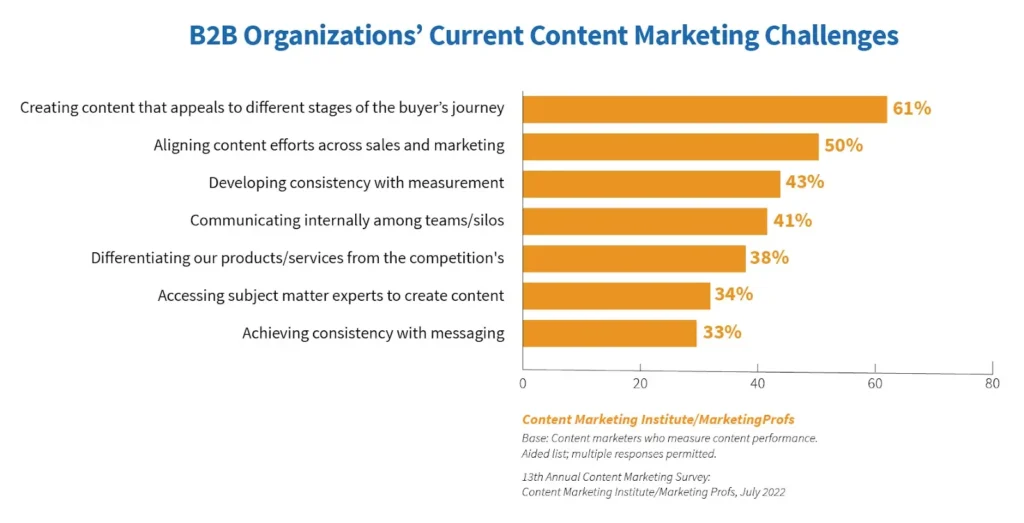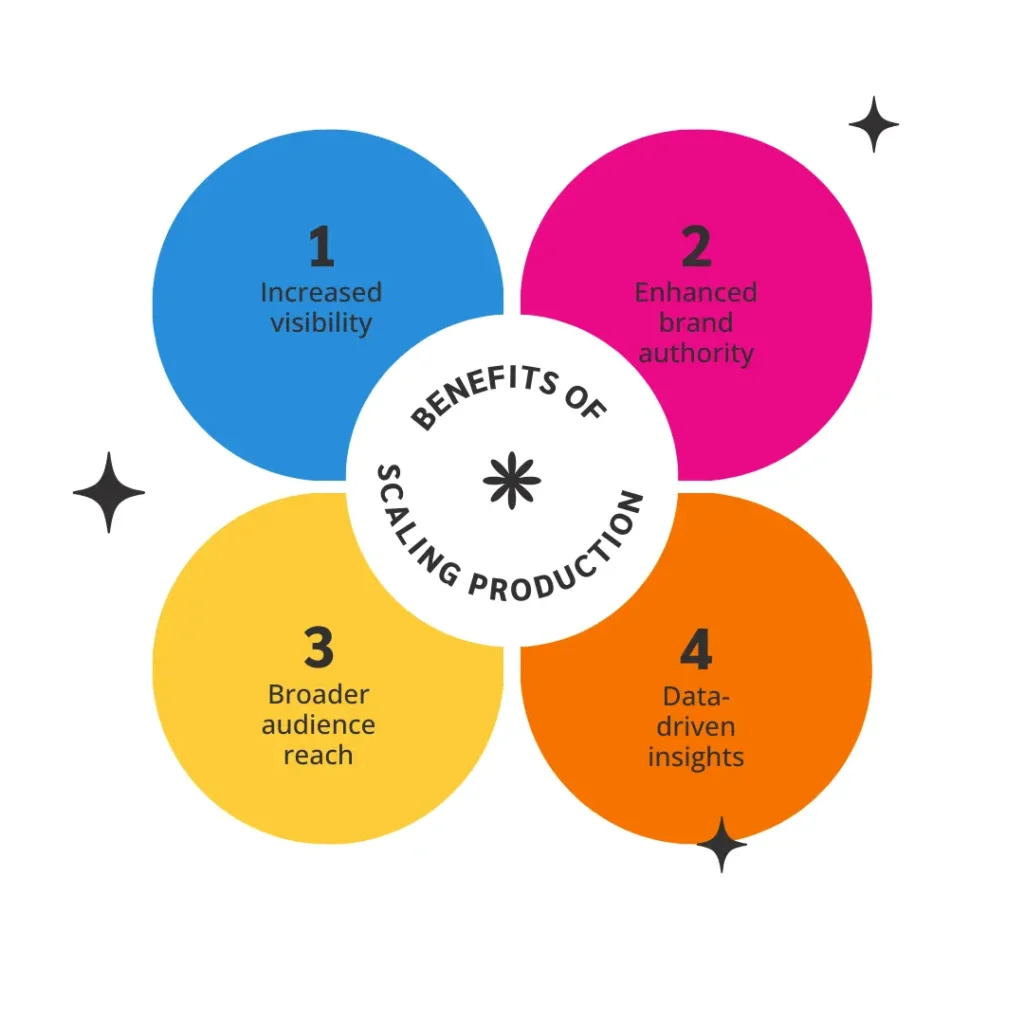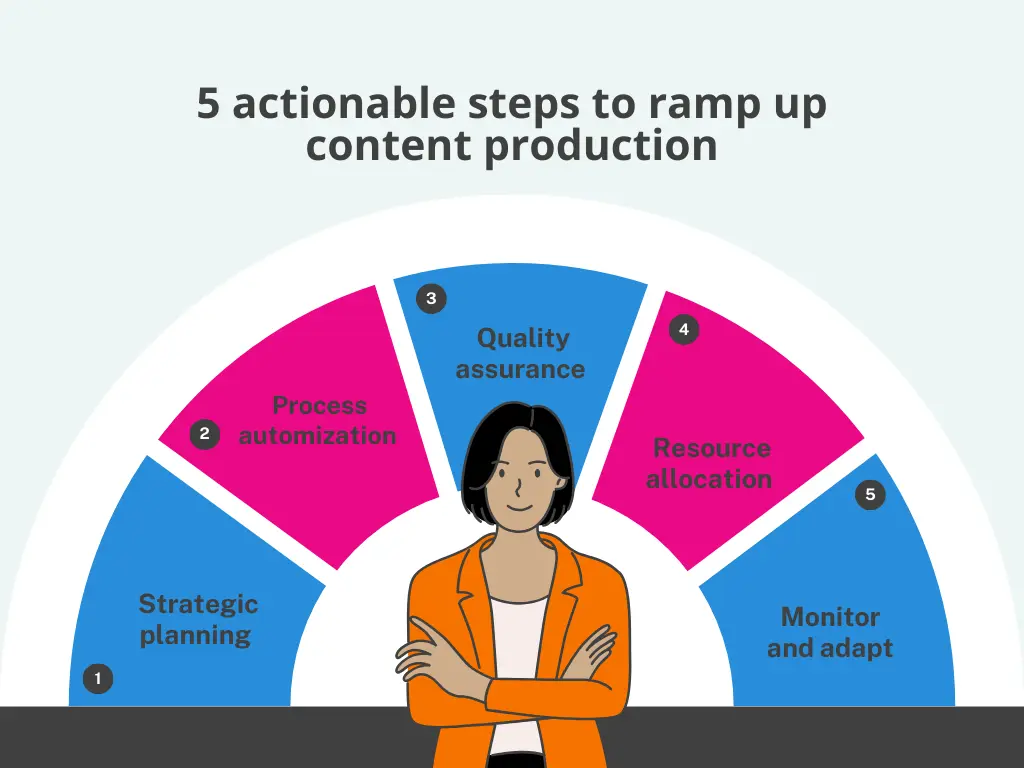Scaling content production is the content team dream. A study by Semrush found that 44 percent of content marketers found success in publishing more content and increasing posting frequency.
But you don’t want to increase volume for volume’s sake. So, how does your team create more content to reach audiences across different channels without diminishing quality or going full bananas?
The ticket to smart scaling is setting your team up for success from the jump. So, stick around if you’re ready to enhance brand presence, reach people at different stages of the customer journey, and turn converted customers into brand champions through a growing content ecosystem.
Why scaling content matters for brand growth
Scaling content production can feel like turning your team into a conveyor belt of low-value blog posts with an endless production line. No thanks!
You shouldn’t simply ramp up the volume and efficiency just for more output—or because someone had a big idea.
When producing more content, the goal is to grow your library without sacrificing quality. A survey from Your team should maintain high value by creating on-brand, informative, and helpful assets that build trust and move buyers through decision-making. For B2B companies, establishing a solid relationship may take months or even years.
The Content Marketing Institute revealed that 61 percent of content teams find it challenging to develop content that appeals to different stages of the buyer’s journey. To achieve production goals that align with company growth, scaling necessitates improving processes and workflows, adopting new tools to support human activities, and optimizing resources so that you work more efficiently regardless of your team size.

Source: Content Marketing Institute
4 undeniable benefits of scaling content production
- Increased visibility: Producing a greater volume of high-value content increases a brand’s chances of appearing in search results, social media feeds, and other platforms, helping to have a great share of voice in the market.
- Enhanced brand authority: Many customers enter the conversation with your company through content, so a great volume gives you more opportunities to establish your brand as an authority.
- Broader audience reach: Your company can leverage these assets to build campaigns, support sales conversations, and grow their personal brands on LinkedIn, whether it’s to become an internal influencer for the company or as a tool for social selling.
- Data-driven insights: Improving content velocity and output provides more data, allowing your team to gain more insights into audience behaviors and preferences, which can inform the marketing team’s decisions.

Maintaining content consistency at scale
McDonald’s didn’t become an industry leader because they had the best burgers around. The company is renowned for scaling efficiently through well-defined workflows and processes.
As volume increases, it’s easy to make errors, miss steps in the workflow, or have resource constraints that pressure the team, leading to subpar work and burnout. You can overcome this by having clear guidelines and a robust editorial process.
You’re not flipping patties, but you can take a page from the McDonald’s playbook. Here’s how.
Standardize content creation
Develop clear content guidelines and templates to ensure tone, style, and quality consistency. Then, train your team and freelancers on these standards and ingrain them in everything they produce. Don’t let anything slip through the cracks; otherwise, as humans do, people start to cut corners and quality tanks.
Make friends with technology
Use content management systems like Webflow or WordPress to house and publish content, project management software such as Monday.com or Asana to keep everyone on track, and content helpers like Grammarly and Jasper.ai to improve ideation, outlining, and editorial processes.
Build a reliable network
Whether you’re a content team of one or have a staff, you want a reliable outside network of freelancers, subject matter experts (SMEs), and agencies to handle overflow.
Regularly review and refine
Content production is never set it and forget it. Conduct regular content performance reviews and content audits to gather feedback that identifies gaps and areas for improvement.
5 actionable steps to ramp up content production
Let’s break it down into actionable steps so your team can build an award-worthy content library that expands your reach and grows with your business.

Step 1: Strategic planning
First, clarify your goals. Are you looking to boost brand awareness, increase engagement, or attract more leads? Knowing this will guide your efforts.
Next, think about your audience. Understanding their demographics and preferences helps you create content that truly connects. With these insights, craft a content strategy that outlines your themes, content types, and the channels you’ll use. Make sure everything aligns with your business goals. Keeping it clear and purposeful will set the stage for success and meaningful engagement.
Step 2: Process optimization
Start by standardizing your workflows—create a consistent content creation, review, and publication approach. This makes everything smoother and more predictable. Then, bring in technology to lighten the load. Use tools that streamline your processes and cut down on manual work.
Finally, set up a content calendar to help you plan and track your production, ensuring everything is delivered and published on time.
Step 3: Quality assurance
Lay the groundwork with comprehensive guidelines—create detailed style and brand guides to ensure everyone is on the same page. Next, implement multi-stage reviews. This way, content is checked at every step, keeping it consistent and top-notch. Lastly, lean on analytics for feedback. Regularly dive into performance data to spot areas for improvement.
Step 4: Resource allocation
Start by assessing your current resources. Look at your team’s capacity and see where there might be gaps. Once you know what you need, it’s time for budget planning. Allocate funds wisely to bring in additional resources and tools. Finally, focus on recruiting and onboarding. Whether hiring new team members or freelancers, ensure they get thorough training to hit the ground running.
Step 5: Monitor and adapt
Begin by regularly reviewing your processes. Continuously refine workflows to boost efficiency and keep things running smoothly. Stay agile by adapting your strategies and methods as market conditions and business needs change.
FAQs
Content teams can scale production while maintaining high quality and brand consistency by establishing clear content guidelines and templates that standardize tone, style, and quality.
Training team members and freelancers on these standards help ensure consistency. Additionally, leveraging technology like content management systems and project management tools streamlines processes and maintains quality as production scales.
Practical strategies for optimizing workflows in content production include standardizing workflows to create a consistent approach for content creation, review, and publication. Adopting technology to automate and streamline processes reduces manual work and enhances efficiency. Implementing a content calendar aids in planning and tracking production, ensuring timely delivery and publication of content.
Strategic planning is necessary for successful content scaling and audience engagement because it involves setting clear goals, understanding the target audience, and crafting a content strategy that aligns with business objectives.
By focusing on themes, content types, and distribution channels, strategic planning ensures that content resonates with the audience and fulfills the company’s growth ambitions, driving meaningful engagement and brand loyalty.
Don’t lose sight of the main goal: Helping your audience
As your team grows, always keep your audience in mind. Share compelling stories that draw them in and assist them in their decision-making journey. Integrate case studies, data, and product details to distinguish your brand from others. Start small—experiment, learn, and refine before scaling up.
Seek feedback from your team and the broader organization as you evolve, and be transparent about any hurdles you encounter. Setting achievable goals is crucial—they should be something your team can reach and take pride in. Remember, what works for one company might not suit yours, so stay realistic.
Build a team atmosphere where members are excited to collaborate and contribute to your content strategy. If something isn’t working, don’t be afraid to change course. It’s better to pivot with a new plan than to continue down an unproductive path.




